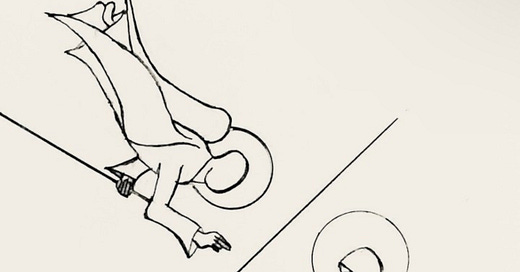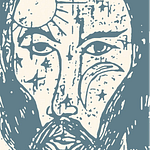Two questions have been on my mind in thinking through a theology of angels. First, why is it that in the story of Jacob’s Ladder (and again in John 1:51) that the angels ascend and then descend? We would imagine they would first descend from heaven to what is lower—the earth—and then ascend. So, why the reversal of the movement of angels? The second question is deeply connected to the first: why does Peter tell us in 1 Peter 1:12 that the angels long to look into the mystery of the gospel?
To get at something of an answer to these two questions we looked at the two angelic choirs that are located at the top of the angelic hierarchy: Cherubim and Seraphim (or vice versa).
Traditionally Christians have noted that Scripture speaks of nine different choirs of angels and theologians throughout the church’s tradition have ranked these nine choirs into three groups of threes (with differing orders depending on the theologian you’re reading!). The top triad is said to be closest to God’s throne while the bottom triad is closest to the earth.
Top: Cherubim, Seraphim, Thrones Middle: Dominions, Powers, Authorities Bottom: Principalities, Archangels, Angels
In Scripture when we are given a glimpse of God’s throne room through prophetic vision it is the Cherubim and Seraphim that we find closest to the throne (see Rev. 4-5, Isa. 6, Ezek. 1).
The tradition is established from the beginning in Genesis. Adam and Eve are expelled from the Garden of Eden and God places the Cherubim with a flaming sword to guard the way to the Tree of Life.
We find the Cherubim closest to God’s throne again in Exodus. The Lord instructs Moses to have two Cherubim of gold made and placed on top of the Ark of the Covenant—one on each end. And God promises Moses this: “There, above the cover between the two cherubim that are over the ark of the covenant law, I will meet with you” (Exodus 25:22).
But the deep secret of the throne room of God—the things into which angels long to look and yet cover their faces with their wings—is that on God’s throne sits a human being, something lower than all the angels (Heb. 2:6—8). In Ezekiel’s vision of God’s throne chariot by the River Chebar we find that the one seated on the throne is one “like a man.”
How is it that the one seated on the throne in God’s most holy throne room—which is surrounded by the Cherubim and Seraphim—looks like a human being? The ancient church fathers responded: “Because he is one!”
Gregory the Great (6th century) preaching on this text from Ezekiel is crystal clear:
We should observe how the order is maintained: above the living beings is the firmament, above the firmament is the throne, and above the throne a man is delineated. For above holy men still living in…the body are the angels, and above the angels are superior angelic powers closer to God, and above the powers is…the man Christ Jesus.
But notice that the “order” which is “maintained” is actually reversed. Above human beings are the angels, and above the angels are the higher angelic beings who are closer to God (and so further away from human beings), and yet above these powers is the human being Christ Jesus.
John’s Gospel gives us the clue. The way Jesus speaks in the Gospel of John shows that he sees the cross as his throne. “When I am lifted up [on the cross] I will draw all men to myself.” From the cross the last words of Jesus are not despairing, but triumphant. Not “My God why have you forsaken me?” but “It is finished.”
Listen to the way John depicts the scene of Golgotha: “And carrying his own cross, he went out to the place of the Skull (which in Aramaic is called Golgotha). There they crucified him, and with him two others—one on each side and Jesus in the middle” (John 19:17–18).
Just as the two cherubim made for the ark of the covenant were to be on each side of the “mercy seat” and God promises that he will meet the Israelites between the two cherubim, so Jesus is enthroned “in the middle” with “one on each side.”
This is the secret of God’s throne room: the one on the throne which the angels face is a human being. But he is not only a human being, he is the crucified human being. This is why the angels hide their faces with their wings. They long to look at the deep mystery of the gospel, but it is too much to take in. Not simply because it is “high and exalted” but because it is so high and exalted that it comes in meekness and humility. The way Jesus is high and exalted is by being lowly.
This is why the angels first ascend and then descend. The one seated on the throne—to which they ascend—is the one who has descended to the lowest depths, and continues to descend into all things in order to fill all things with himself.
The angels’ ascending and descending are not two movements but one. Their ascending is their descending. The higher they ascend, the lower they descend because the one they ascend to is the crucified one who descends into death, into hell.
This is why Moses could not see the face of God. God hides him in the cleft of the rock, just as the angels hide their faces. Why? Because if Moses would’ve seen the face of God, he would’ve seen the face of a Jewish carpenter. He would’ve seen the face that Mary smothered with kisses.
That alone would’ve been too much for him to take in. But there is more. Not only would he have seen the face of Jesus, but in the face of Jesus he would’ve seen his own face. Christ, who is our life, has taken the faces of all humanity into himself and seated us with him in the heavenly places.
Or as Jesus promises to the church of Laodicea in Revelation 3:21—22 “To the one who is victorious, I will give the right to sit with me on my throne, just as I was victorious and sat down with my Father on his throne.”
The angels in the throne room face God. But the God the angels face is no longer other than the one who became human, and he has seated us on his throne between the cherubim and seraphim.
It’s all really too much to take in.














Share this post